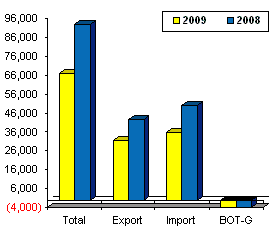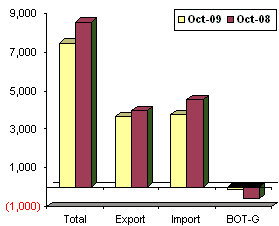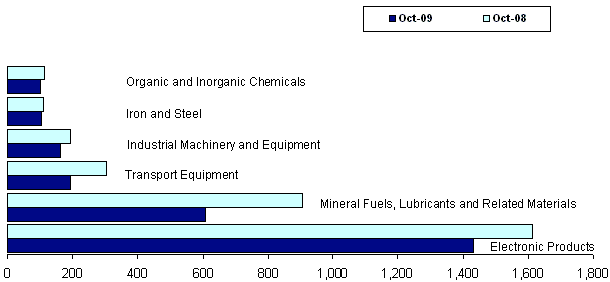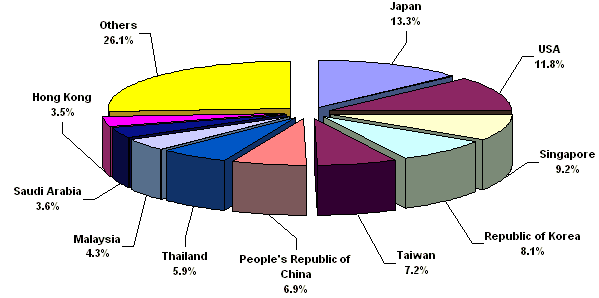| |||||||||||||||||||||||||||||||||||||||
p - preliminary
r - revised
Top 10 Philippine Imports from All Countries: October 2009 | |||
Gainer | Losers | ||
Metalliferous Ores and Metal Scrap | 109.7 | Transport Equipment | -35.9 |
|
| Mineral Fuels, Lubricants and Related Materials | -32.9 |
|
| Plastics in Primary and Non-Primary Forms | -19.2 |
|
| Industrial Machinery and Equipment | -16.2 |
|
| Electronic Products | -11.3 |
|
| Organic and Inorganic Chemicals | -10.0 |
|
| Cereals and Cereal Preparation | -8.2 |
|
| Telecommunication Equipment and Electrical Machinery | -8.2 |
|
| Iron and Steel | -6.3 |
JANUARY TO OCTOBER 2009 TOTAL TRADE STOOD AT $66.796 BILLION
Total external trade in goods for January to October 2009 amounted to $66.796 billion, a 28.1 percent decline from $92.850 billion registered during the same month in 2008. Total imports posted a 29.0 percent annual decrease from $49.960 billion to $35.485 billion. Total exports likewise slipped by 27.0 percent from $42.890 billion in January to October of 2008 to $31.311 billion. Thus, the balance of trade in goods (BOT-G) for the Philippines posted a deficit of $4.175 billion during the 10-month period in 2009, a value less than the $7.070 billion deficit in the same 10-month period last year.
Figure 1A Philippine Trade Performance in January - October : 2009 and 2008
(F.O.B. Value in Million US Dollars)

Figure 1B Philippine Trade Performance in October : 2009 and 2008
(F.O.B. Value in Million US Dollars)

OCTOBER 2009 IMPORTS FELL BY 16.8 PERCENT
Combined import and export merchandise trade for October 2009 dropped by 12.7 percent from $8.568 billion in October 2008 to $7.478 billion. This was due to the decrease in total merchandise imports by 16.8 percent from $4.578 billion in October 2008 to $3.808 billion. Similarly, total exports declined by 8.0 percent from $3.990 billion to $3.670 billion. The balance of trade in goods (BOT-G) in October 2009 recorded a deficit of $138 million, lower than the last years recorded deficit of $588 million. On a month-on-month basis, total imports for October 2009 inched up by 3.8 percent from $3.670 billion recorded in September 2009.
ELECTRONIC PRODUCTS ACCOUNTED FOR 37.6 PERCENT OF IMPORT BILL
Accounting for 37.6 percent of the aggregate import bill and the countrys major commodity imported in October 2009, payments for Electronic Products including consigned and direct importation using the expanded coverage of electronic products amounted to $1.431 billion in October 2009. It went down to 11.3 percent over last year's figure of $1.614 billion. This was due to the 12.9 percent decrease inComponents/Devices (Semiconductors) which comprised the biggest share of 27.9 percent among the major groups of electronic products. However, electronic products showed an increase of 7.6 percent month-on-month from $1.331 billion in September 2009.
Imports of Mineral Fuels, Lubricants and Related Materials comprising 16.0 percent of the total imports in October 2009 ranked second. This commodity group decelerated by 32.9 percent from $905.42 million to $607.92 million.
Transport Equipment, amounting to $194.49 million was the Philippines third top import for the month with 5.1 percent share to total imports and recorded the highest annual decrease of 35.9 percent among top ten imports from previous years level of $303.35 million to $194.49 million.
Contributing 4.3 percent to the total import bill and the countrys fourth top imports in October 2009 wasIndustrial Machinery and Equipment with payments placed at $162.79 million. The amount decelerated by 16.2 percent from last years recorded value of $194.36 million.
Fifth in rank and with 2.7 percent share, Iron and Steel registered $103.88 million worth of imports, lower by 6.3 percent from its year ago level of $110.90 million.
Organic and Inorganic Chemicals exhibiting 2.7 percent of the total imports ranked sixth, valued at $101.62 million and showed a decrease of 10.0 percent from its year ago level of $112.91 million.
Rounding up the list of the top ten imports for October 2009 were Telecommunication Equipment and Electrical Machinery including telecommunications and sound recording and reproducing apparatus and equipment, accounting for $81.03 million decreased by 8.2 percent; Cereals and Cereal Preparationsamounting to $77.48 million went down by 8.2 percent; Plastics in Primary and Non-Primary Forms valued at $76.24 million fell by 19.2 percent; and Metalliferous Ores and Non-Primary Forms worth $73.56 million jumped to 109.7 percent, the biggest annual growth from among the top ten imports.
Aggregate payment for the countrys top ten imports for October 2009 reached $2.910 billion or 76.4 percent of the total import bill.
Figure 2 Philippine Top Six Imports in October : 2009 and 2008
(F.O.B. Value in Million US Dollars)

RAW MATERIALS AND INTERMEDIATE GOODS ACCOUNTED FOR 39.8 PERCENT OF THE TOTAL IMPORTS
Accounting for 39.8 percent of the total imports, payments in October 2009 for Raw Materials and Intermediate Goods amounted to $1.516 billion or 11.1 percent decline over last year's figure of $1.704 billion. Compared to the previous months level, purchases climbed to 11.8 percent from $1.356 billion. Semi-Processed Raw Materials having the biggest share of 34.9 percent and valued at $1.327 billion decreased by 14.0 percent year-on-year from $1.543 billion.
Capital Goods, contributing 31.6 percent to the total imports, plummeted by 16.3 percent from $1.439 billion in October 2008 to $1.205 billion. Similarly, Mineral Fuels, Lubricants and Related Materials with 16.0 percent share, contracted by 32.9 percent from its year ago level of $905.42 million to $607.92 million.
Purchases of Consumer Goods amounted to $413.79 million or a negative growth of 12.8 percent from $474.62 million in October 2008, while Special Transactions showed a growth of 22.0 percent to $65.78 million from $53.92 million in October 2008.
Figure 3 Philippine Imports by Major Type of Goods in October : 2009 and 2008
(F.O.B. Value in Million US Dollars)

JAPAN ACCOUNTED FOR 13.3 PERCENT OF IMPORT BILL
Japan including Okinawa, the countrys biggest source of imports for October 2009 with 13.3 percent share, recorded payments worth $506.73 million contracting by 16.0 percent from $603.54 million in October 2008. Revenue from the countrys exports to Japan, on the other hand, reached $598.92 million, generating a total trade value of $1.106 billion and $92.18 million trade surplus for the Philippines.
United States of America (including Alaska and Hawaii) with 11.8 percent share of the total import bill amounting to $447.87 million followed as the second biggest source of imports for October 2009. This value islower by 25.2 percent from $598.49 million recorded in October 2008. Exports to USA amounted to $660.48 million, yielding a two-way trade value of $1.108 billion and a trade surplus of $212.61 million.
Singapore came third, accounting for 9.2 percent share of the total import bill in October 2009 decreased by 14.3 percent from $407.74 million in October 2008 to $349.40 million in October 2009. Exports toSingapore amounted to $216.15 million resulting to a total trade value of $565.55 million and a trade deficit of $133.25 million.
Ranked fourth in October 2009 and with 8.1 percent share was Republic of Korea valued at $309.86 million. This amount increased by 30.2 percent from $237.92 million posted in October 2008. Exports to Republic ofKorea amounted to $192.52 million resulting to a total trade value of $502.38 million and a trade deficit of $117.33 million.
Fifth in rank is Taiwan, representing 7.2 percent of the total import bill in October 2009, amounting to $275.83 million. Export receipts from Taiwan in October 2009 reached $96.72 million yielding a total trade value of $372.55 million and a trade deficit of $179.11 million.
Other major sources of imports for the month of October 2009 were Peoples Republic of China, $262.43 million; Thailand, $224.30 million; Malaysia including Sabah and Sarawak, $164.69 million; Saudi Arabia, $138.27 million; and Hong Kong, $134.56 million.
Payments for imports from the top ten sources for October 2009 amounted to $2.814 billion or 73.9 percent of the total import.
Figure 4 Philippine Imports by Country in October : 2009

IMPORTS FROM EASTERN ASIA WORTH $1.492 BILLION
Philippines total imports in October 2009 with Eastern Asia (China, Hong Kong, Japan, Macau, Mongolia, North Korea, South Korea and Taiwan) represented 39.2 percent of the county�s total imports with total payments of $1.492 billion or a negative growth of 9.6 percent from October 2008 level of $1.650 billion. Total exports to member-countries of Eastern Asia was valued at $1.368 billion, resulting to a total trade of $2.860 billion and a balance of trade in goods (BOT-G) deficit of $124.10 million.
Imports from ASEAN member-countries in October 2009 accounted for 23.3 percent share, a decrease of 15.6 percent from $1.050 billion registered in October 2008 to $886.11 million. Exports to ASEAN member-countries worth $552.17 million resulted to a total trade of $1.438 billion and trade deficit of $333.94 million.
October 2009 imports from European Union were valued at $271.56 million while exports to member-countries of European Union were worth $904.35 million. This aggregated to total trade of $1.176 billion and a trade surplus of $632.78 million.
Figure 5 Philippine Imports by Selected Economic Bloc in October : 2009
(F.O.B. Value in Million US Dollars)

Technical Notes:
1. Adjustments on electronic import statistics are based on the transactions that pass through the Automated Cargo Operating System (ACOS) of the Bureau of Customs (BOC).
2. Starting with the January 2007 Press Release, analysis and tables are based on the 2004 Philippine Standard Commodity Classification (PSCC) groupings. This is in compliance with NSCB Resolution No. 03, Series of 2005 entitled "Approving and Adopting the 2004 Philippine Standard Commodity Classification" by all concerned government agencies and instrumentalities.
(Sgd.) CARMELITA N. ERICTA |
Source: Foreign Trade Statistics Section
Industry and Trade Statistics Department
National Statistics Office
Manila, Philippines
